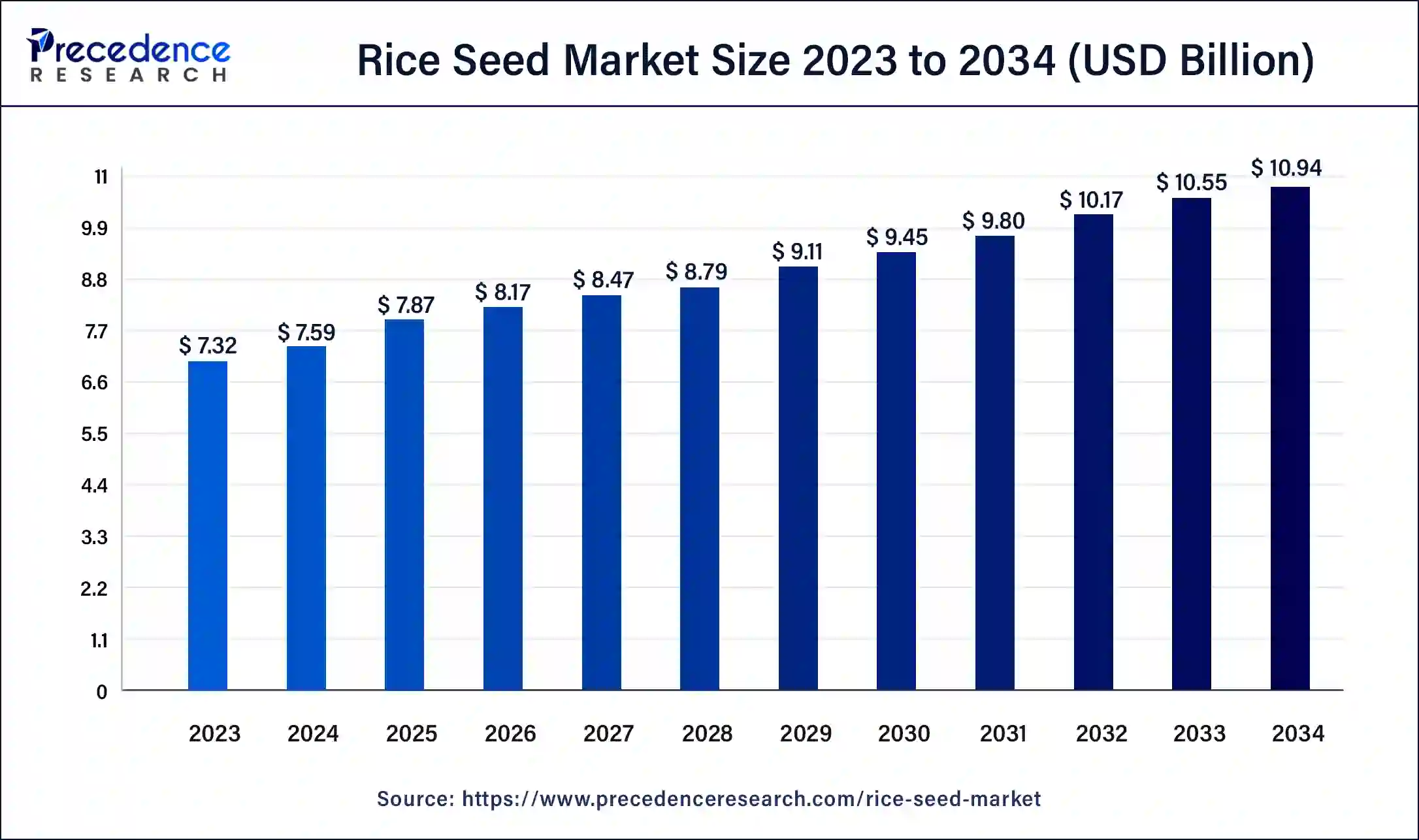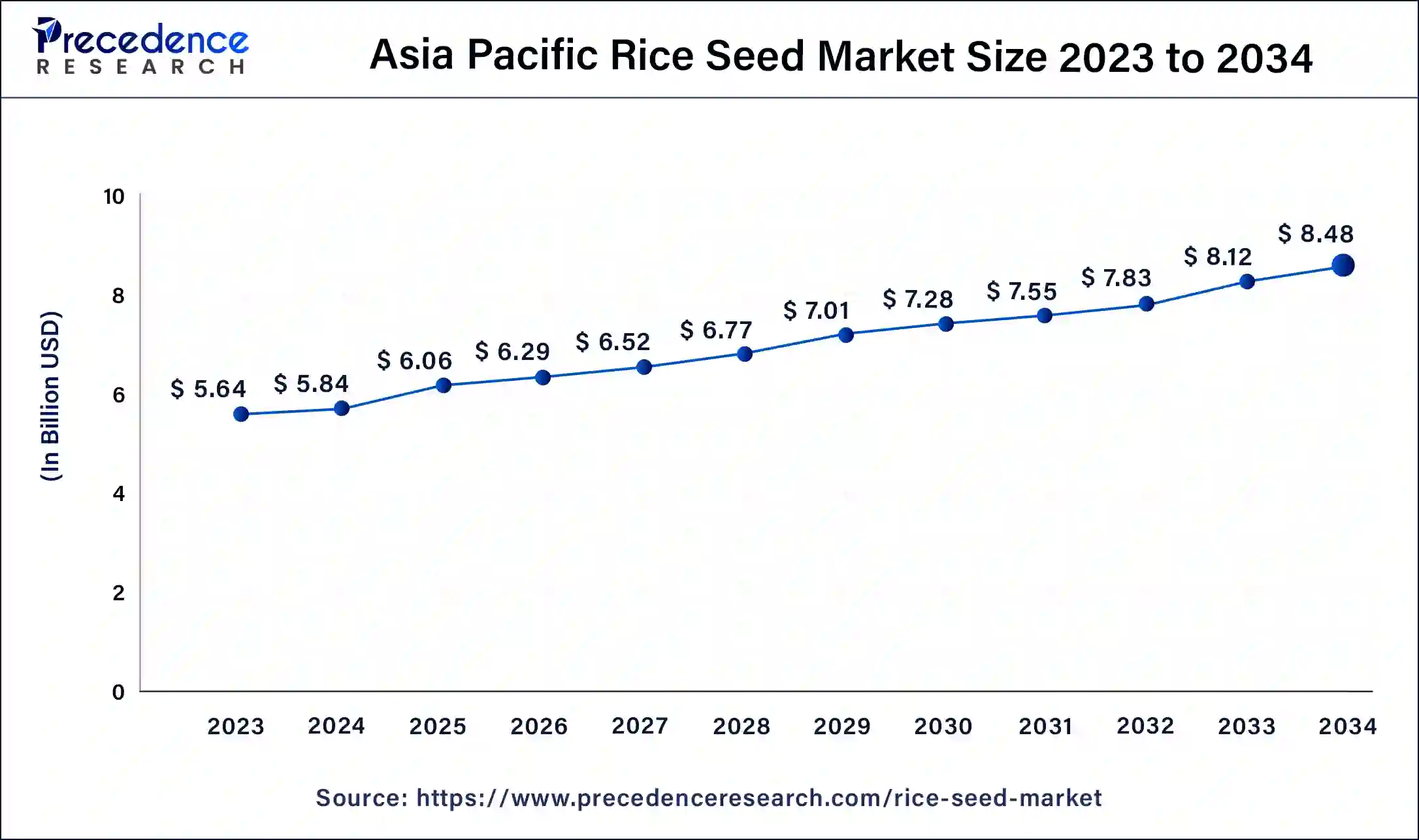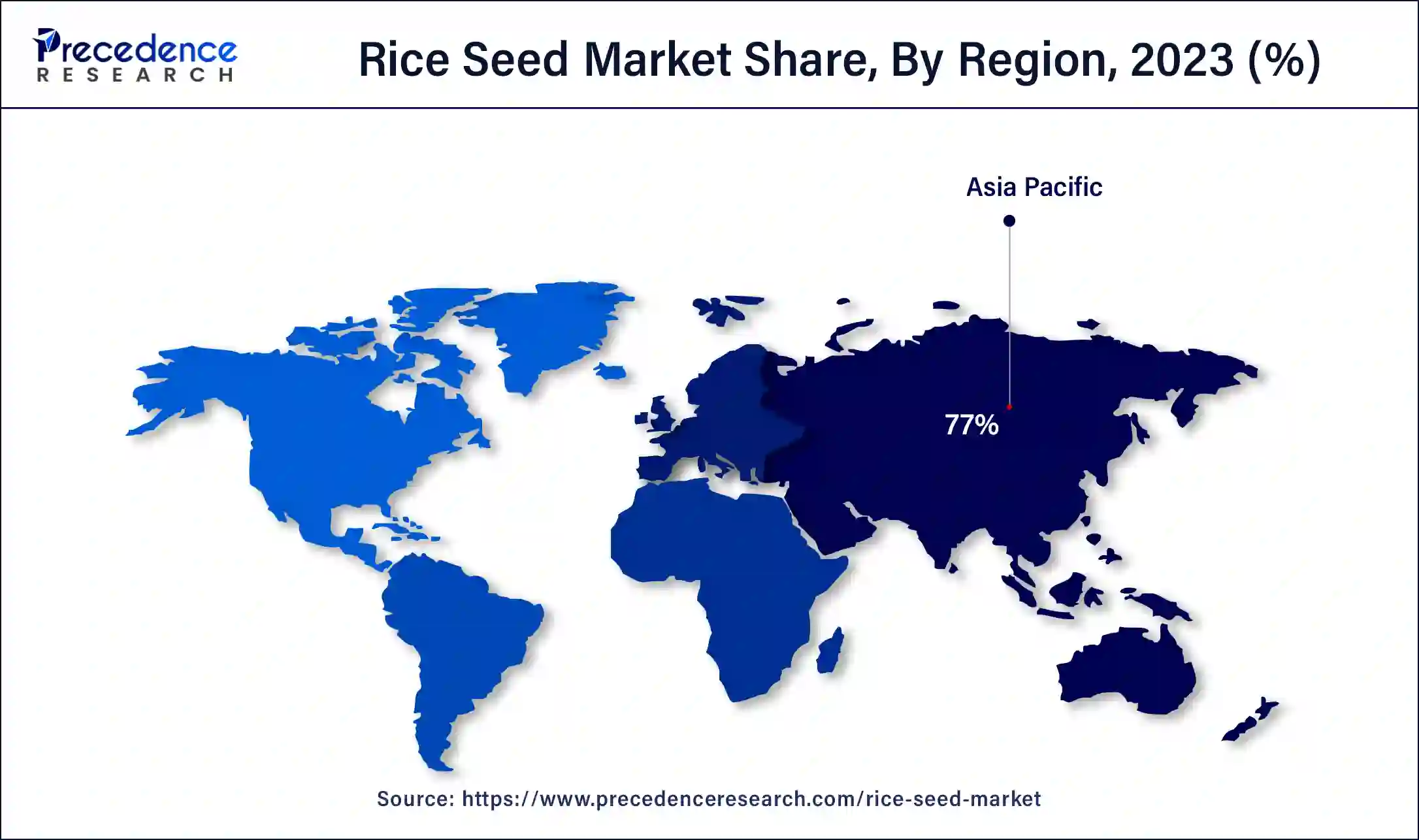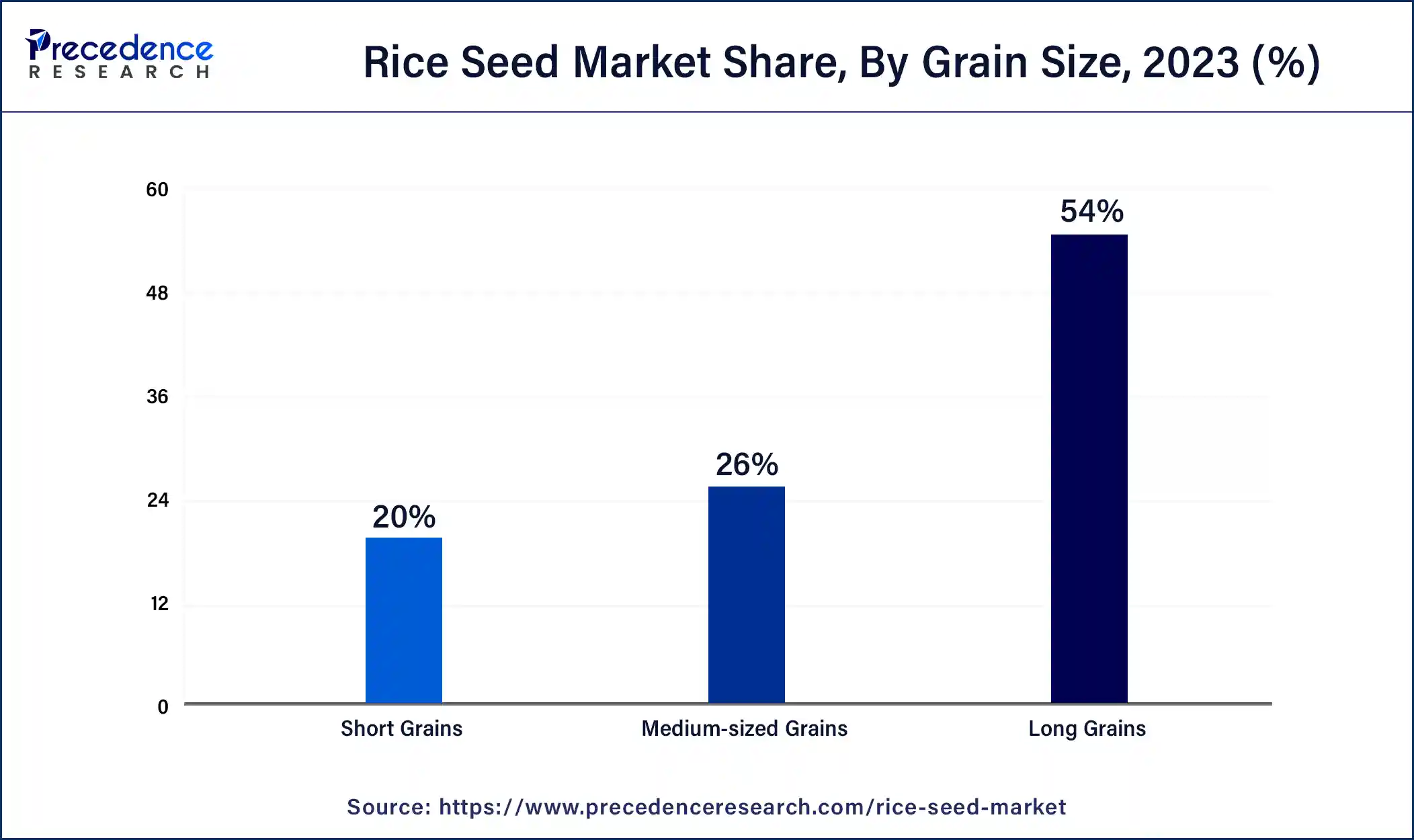List of Contents
Rice Seed Market Size and Forecast 2025 to 2034
The global rice seed market size was worth around USD 7.59 billion in 2024 and is anticipated to reach around USD 10.94 billion by 2034, growing at a CAGR of 3.72% over the forecast period 2025 to 2034. The growing adoption of hybrid rice seeds is expected to drive the growth of the rice seed market.

Rice Seed Market Key Takeaways
- In terms of revenue, the rice seed market is valued at $7.87 billion in 2025.
- It is projected to reach $10.94 billion by 2034.
- The rice seed market is expected to grow at a CAGR of 3.72% from 2025 to 2034..
- Asia Pacific dominated the global rice seed market with the largest market share of 77% in 2024.
- North America is expected to witness significant growth over the forecast period.
- By grain size, the long-grain rice seeds segment contributed the biggest market share of 54% in 2024.
- By treatment, the untreated rice seeds segment accounted for the highest market share in 2024.
- By hybridization technique, the three-line system segment is attributed to having the highest share of the market in 2024.
How can Artificial Intelligence (AI) improve the Rice Seed Market?
Artificial intelligence techniques have great potential to offer data related to the quality of soil, when to sow in agriculture, and where to spray herbicide; this is the maximum probability of pest infestation. AI technology has been used globally, which aids farmers in optimizing the efficiency for monitoring crop health in the rice seed market. They can be used to manage diseases in rice seeds. AI techniques that have been used for creating and developing intelligent machines are used for rice seed management with higher accuracy than humans can.
Asia Pacific Rice Seed Market Size and Growth 2025 to 2034
The Asia Pacific rice seed market size was exhibited at USD 5.84 billion in 2024 and is projected to be worth around USD 8.48 billion by 2034, poised to grow at a CAGR of 3.80% from 2025 to 2034.

Asia Pacific dominated the global rice seed market in 2024. The region is a major producer and consumer of rice in the world. The insufficient agricultural land has inspired farmers to better yield from their cultivation in the region. The rising adoption of advanced technologies such as certified and hybrid seeds is also growing. With the various market players who have technological capacities, strong research and development activities, and global presence to address the increasing demand across the globe, the market for the competitive landscape of rice seeds is highly fragmented. Collaboration and new product launches are some of the policies that are being integrated by market players.
In addition, China and India are the fastest growing countries in rice and these countries have top companies in the rice seed market. In China, there are various top companies in rice seed, such as Zhongnongfa Seed Industry Group Co. Ltd, Yuan Longping High-Tech Agriculture Co. Ltd, Hefei Fengle Seed Industry Co. Ltd, Beidahuang Kenfeng Seed Co. Ltd, Anhui Tsuen Yin Hi-Tech Seed Industry Co. Ltd, and many others.
- In August 2024, Prime Minister Narendra Modi released 109 high-yielding and climate-resilient varieties of seeds, two people aware of the matter told Mint. These 109 varieties of 61 crops include 34 field crops and 27 horticultural crops. These crop seeds will be for wheat, rice, vegetables, oilseeds, and cotton, among others.
- In May 2024, Savannah Seeds launched its groundbreaking FullPage Rice Cropping Solution to the Indian market, in collaboration with a leading global crop protection company, ADAMA India. This solution was launched at a program attended by over 1000 farmers from across the region at Bemetara.

North America is expected to witness significant growth in the rice seed market over the forecast period. North America is also showing significant growth in rice seeds due to consumers' good eating habits. The U.S. and Canada are the major countries in the region. After sorghum, wheat, and corn, rice production is the fourth largest among cereals in the U.S. rice farms have the highest national land and are the most capital-intensive due to the row crop farms in the U.S. rice production is connected to the agriculture using first planting African rice and labor in the American South.
- In May 2024, a subsidiary of the U.S.-based RiceTec, Savannah Seeds, launched a new technology called FullPage Rice Cropping Solution to promote DSR (direct seeded rice) farming. The new integrated solution helped farmers reduce greenhouse gas emissions and substantially reduce labor costs.
Market Overview
The rice seed market deals with a diverse range of professional parties, such as agricultural researchers, seed producers, breeders, government agencies, and farmers. Breeders must conduct detailed research and development to create new rice varieties and focus on characteristics that boost productivity and resistance. These modified rice seeds are made available and produced via a variety of channels, such as seed corporations, cooperatives, and government initiatives.
The increasing consumption of rice as a major food crop over the globe is expected to drive the growth of the rice seed market. Rice seeds are commonly available in jasmine, white, brown, basmati, and arborio rice seed variants. In addition, there is an increasing demand for OPV seeds, with the increasing adoption of organic rice-based farming practices to address the growing consumers' food requirements.
Rice Seed Market Growth Factors
- With the rapidly growing world population, the demand for rice to fulfill the rising food consumption is expected to enhance the rice seed market growth during the forecast period.
- The increasing trend of public-private partnerships in the hybrid rice seed production sector contributed to propelling the market growth.
- The growing cost of premium seeds and rising consumer demand for high-quality rice crops are expected to enhance the market growth.
- The increasing consumer knowledge of the advantages of eating healthy is further expected to drive the growth of the rice seed market.
Market Scope
| Report Coverage | Details |
| Market Size by 2034 | USD 10.94 Billion |
| Market Size in 2025 | USD 7.87 Billion |
| Market Size in 2024 | USD 7.59 Billion |
| Market Growth Rate from 2025 to 2034 | CAGR of 3.72% |
| Largest Market | Asia Pacific |
| Base Year | 2024 |
| Forecast Period | 2025 to 2034 |
| Segments Covered | Grain Size, Treatment, Hybridization Technique, and Regions |
| Regions Covered | North America, Europe, Asia-Pacific, Latin America and Middle East & Africa |
Market Dynamics
Driver
Rising demand for hybrid rice seeds
Hybrid seeds are becoming more and more popular due to their increased resilience and production to pests and illnesses. Hybrid rice seeds held a significant share of the rice seed market in recent years, and this market share is expected to rise in the coming years. The necessity to increase rice output to address the demands of an increasing population is accelerating the increasing demand for hybrid rice seeds.
- In March 2025, the International Rice Research Institute (IRRI) launched a new AI-powered digital platform that can substantially advance and accelerate hybrid rice breeding and parental selection around the world, contributing to improved food security and sustainable agriculture through the propagation of high-yielding and climate-smart rice hybrids.
Restraint
High R&D costs and regulatory hurdles
The higher adoption of hybrid rice is hampered by factors such as high research and development costs and longer regulatory approvals. Due to the frequent changes in law amendments and enforcement, regulatory approvals are time-consuming and are regulated by the regulations and rules laid down by the government. For instance, in developing countries, seed bills were passed, which spoiled seed freedom and sovereignty with weaker rights of the farmers. These factors cause clashes between the government and farmers, hindering the overall seed industry. Another restraining factor is high R&D costs. Thus, the overall hybrid rice seed manufacturing and development is a costly and long process that acts as a major challenge and is further expected to restrain the growth of the rice seed market.
Opportunity
Digital agriculture, precision farming, and evolving distribution routes
The increasing adoption of data analytics and digital technologies in agriculture is expanding the rice seed market. Precision farming techniques enable farmers to make valid decisions regarding seed application and selection based on site-specific variables, and that's why they improve yields and resource utilization.
The evolving distribution routes in the rice seed market are creating new opportunities. Traditional seed distribution methods are changing because more farmers are using mobile applications and internet platforms. These platforms allow farmers to communicate directly with seed producers and make it easier for them to access high-quality seeds. This trend is expected to become more popular, especially in developing countries.
- In December 2024, the Bhabha Atomic Research Centre (BARC), Mumbai, introduced eight new high-yielding, climate-resilient varieties of wheat, rice, and oilseeds. Developed using radiation-based mutation breeding techniques, these non-GMO crop varieties are set to "revolutionize" agriculture across India, the BARC said in a statement.
Grain Size Insights
The long-grain rice seeds segment is expected to grow at the fastest rate in the rice seed market during the forecast period. This is leading to a high rate of cultivation in various countries such as Asia Pacific and North America. Long-grain rice is thinner and longer than short-grain rice. This results in a more fluffy, dry, and separate texture when cooked. After cooking, the longer grains also tend to hold their shape better. This long-grain rice has a neutral and mild flavor. This makes it more versatile for pairing with a various range of sauces and dishes. It also had a more delicate aroma. Long-grain rice varieties tend to have a lower carbohydrate and calorie content per serving due to their longer grain shape. Due to the slightly longer cooking time, long rice grain is beneficial for certain meal preparation and cooking methods.

Treatment Insights
The untreated rice seeds segment accounted for the highest share of the rice seed market in 2024. Treatment of seeds and their adoption has been receiving attraction for field crops, such as soybean, wheat, and corn, to minimize crop loss from pest attacks. Rice is particularly cultivated in countries such as Asia Pacific. Farmers are preferred adopting the traditional techniques of crop protection and are reluctant to invest capital in crop inputs. The increasing need for integrated pest management and sustainable agriculture management guidelines conducted by governments has inspired farmers to adopt seed coating technologies in Asian countries.
Hybridization Technique Insights
The three-line system segment is attributed to having the highest share of the rice seed market in 2024. The three-line systems are adopted by major players in the Asia countries for hybrid seed production. Various companies have been depending on the three-line system for product development. A major advance in rice breeding is hybrid rice development. It has demonstrated its immense potential in improving rice productivity. The restoration of fertility of the widely used wild-abortive type of cytoplasmic male sterility is controlled by Rf3 and Rf4 in the three-line system of hybrid rice.
Rice Seed Market Companies
- Pioneer
- Bayer Cropscience
- Syngenta AG
- Advanta Limited
- BioSeeds Research India Pvt. Ltd.
- Biostadt India Limited
- Krishidhan Seeds Pvt. Ltd.
- Nuziveedu Seeds Ltd.
- Rasi Seeds (P) Ltd.
- RiceTec Inc.
- Ankur Seeds Pvt. Ltd.
- Nath Bio-Genes (I) Ltd.
- SL Agritech Corporation
- Nirmal Seeds Pvt. Ltd.
- National Seeds Corporation Limited
- Maharashtra Hybrid Seeds Company Pvt. Ltd.
- Siri Seeds Pvt. Ltd.
- Super Seeds (P) Ltd.
- Krishak Bharati Cooperative Ltd.
Recent Developments
- In January 2025, Horizon Ag incorporated new rice varieties into its portfolio in the Clearfield and Provisia systems that performed well across the Midsouth and Gulf Coast. These varieties will be available in the coming season, along with a new medium grain and a high-amylose long grain. During the recent USA Rice Outlook Conference, Horizon Ag CEO Tim Walker took a moment to discuss the company's portfolio.
- In May 2024, Savannah Seeds, a subsidiary of the U.S.-based RiceTec, introduced a new technology called FullPage Rice Cropping Solution to promote DSR (direct-seeded rice) farming. Besides saving water, the new integrated solution will help farmers substantially reduce labor costs and greenhouse gas emissions by about 25%.
- In May 2024, Pusa Institute, New Delhi, launched the seed sale of RobiNOweed Basmati Rice Varieties, namely, Pusa Basmati 1979 and Pusa Basmati 1985, tolerant to Imazethapyr 10% SL for Direct Seeded Rice cultivation. Speaking on the occasion, Dr Ashok Kumar Singh, the Director of IARI, New Delhi, highlighted the major concerns in rice cultivation in north-western India.
- In May 2024, in New Delhi, Pusa Institute launched the seed sale of RobiNOweed basmati rice varieties. Pusa Basmati 1979 and Pusa Basmati 1985 are the first non-GM herbicide tolerant basmati rice varieties tolerant to Imazethapyr 10% SL to be released for commercial cultivation in India.
- In December 2022, Seed Equal- Delivering Genetic Gains to Farmers Fields Initiative, its new global initiative, was launched by OneCGIAR-IRRI. In partnership with the Vietnam Academy of Agriculture Sciences (VAAS) and Cuu Long Delta Rice Research Institute (CLRRI), the launch commenced through the conduct of a workshop.
- In August 2022, the release of seven new rice varieties for cultivation was approved by the National Seed Board of Nepal, namely Ganga Sagar-3, Ganga Sagar-1, Khumal Basmati-16, Hardinath-5, and Ghaiya-3. The newly released cultivars have multiple traits, such as resistance to pests and diseases, good grain quality, and high-grain production.
Segment Covered in the Report
By Grain Size
- Long Grains
- Medium-sized Grains
- Short grains
By Treatment
- Treated
- Untreated
By Hybridization Technique
- Three-line System
- Two-line System
By Geography
- North America
- Asia Pacific
- Europe
- Latin America
- Middle East & Africa
For inquiries regarding discounts, bulk purchases, or customization requests, please contact us at sales@precedenceresearch.com
Frequently Asked Questions
Ask For Sample
No cookie-cutter, only authentic analysis – take the 1st step to become a Precedence Research client